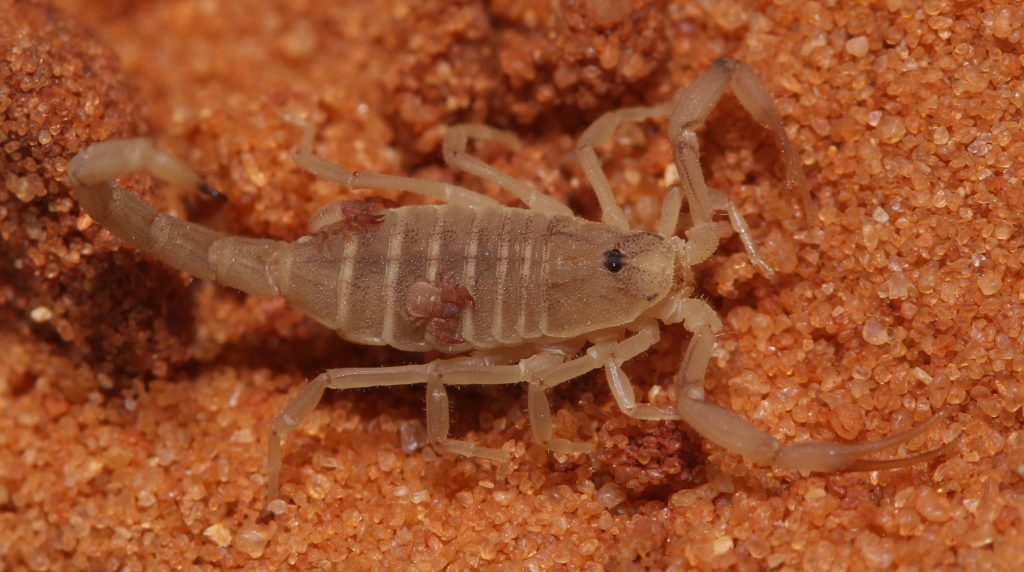
March 18, 2024 — A recent study led by Dr. Sharon Warburg and Dr. Efrat Gavish-Regev from the National Natural History Collections at the Hebrew University of Jerusalem (HU) alongside University of Haifa Ph.D. student Yoram Zvik, documented the first observation of phoresy (a phenomenon where one animal attaches to a host to be taken to new environments) with a pseudoscorpion on a scorpion. The pseudoscorpion Nannowithius wahrmani was observed clinging onto the scorpion Birulatus israelensis. Documented instances of phoresy have been seen in mammals, birds, insects, and even other arachnids.
Nannowithius wahrmani, part of the Withiidae family of pseudoscorpions, encompasses 37 genera and 170 species that can be found all over the world, with a significant presence in tropical and subtropical regions. It was also observed that species within the genus Nannowithius exhibit myrmecophilous tendencies (having positive interspecies associations with ants), often forming a mutually beneficial relationship with ant colonies.

The study conducted was part of an extensive seven-year study, involving field surveys, nest monitoring, and observations in the eastern part of Israel. Over a thousand observations of Birulatus israelensis were documented, with only two observations of the pseudoscorpions species Nannowithius wahrmani on the scorpion’s back during specific dates in late spring.
This groundbreaking observation not only expands our understanding of arachnid behavior but also opens avenues for future research into the intricate world of symbiotic relationships within the ant nest ecosystem. It also prompts further exploration into how pseudoscorpions elude ants, their alternative hosts, and how the arachnids decide to disperse (how they decide to expand the locations in which they live).
The research paper titled “Hitching a ride on a scorpion: the first record of phoresy of a myrmecophile pseudoscorpion on a myrmecophile scorpion” is now available in BioOne Complete and can be accessed here.
Researchers:
Sharon Warburg1, Yoram Zvik2,3, Efrat Gavish-Regev1
Institutions:
1) The National Natural History Collections, The Hebrew University of Jerusalem, Edmond J. Safra Campus, Givat Ram, Jerusalem
2) Hoopoe Ornithology & Ecology Center, Yeroham
3) Department of Evolutionary and Environmental Biology, University of Haifa, Haifa
Related articles
Fighting Antibiotic Resistance with Peptide Cocktails Detailed by Hebrew University Study
July 25, 2024 — In a new development to fighting antibiotic resistance, a new study by researchers at the Hebrew University of Jerusalem found that antimicrobial peptide mixtures offer a lower risk of resistance compared to single antimicrobial peptides (AMPs). The widespread use of antibiotics
Advanced Method for Rock Engraving Analysis: Computational Answers to Riddles on Stone
July 16, 2024 — Ph.D. student Lena Dubinsky and Prof. Leore Grosman from the Computational Archaeology Laboratory at the Hebrew University of Jerusalem’s Institute of Archaeology have pioneered a new method to study rock engravings, merging technological and visual analysis to uncover the
Hebrew University Celebrates ERC Proof of Concept Grants for Pioneering Research in Diagnostics and Therapy
July 16, 2024 — The Hebrew University of Jerusalem proudly congratulates three of its esteemed researchers for receiving prestigious European Research Council (ERC) Proof of Concept (POC) Grants. These grants, each valued at €150,000 (about $163,000 USD), are designed to bridge the gap between



